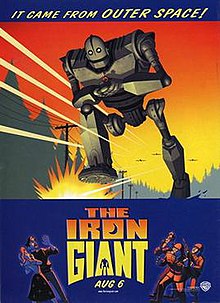Here is the original write-up that I did of the Iron Giant a few years ago.
Last night I watched it again and had a few additional thoughts that I wanted to get down.
1. The Post-War Setting
Hogarth’s father has been killed in action, that much we can get from subtle hints through the movie:
- Hogarth’s Mom is having financial difficulties and works as a waitress, renting out the room in their large house.
- There’s a photo of a man climbing into a vehicle cockpit on Hogarth’s bedside table
- One of the pictures that Mansley develops from Hogarth’s camera is of both Hogarth and his mom, begging the question, who took the picture? I’m guessing his Dad, before he went away
- Annie calls Dean “sweetie” at the movie’s end and has clearly developed a relationship with him, indicating Hogarth’s dad is permanently out of the picture (unless Annie is rocking some seriously progressive relationship dynamics).
But there was something I noticed about twenty minutes in. I had absorbed it but never really thought about the other people in the town – it’s almost all women, kids, and older men. And I realized that it’s because all the younger men were called up for service in the war. And more than likely, didn’t come back. If that’s something intentional on the part of the filmmakers, then BRA-VO. That is a beautifully subtle reality of post-war life.
If this is accurate, then it also adds another layer of subtlety to Dean and Mansley’s characters – Dean might be a conscientious objector; the way the other men in the diner sort of dismiss him could just be because of his beatnik stylings, but it could also be that he’s thought of as a “draft dodger.” And Mansley was left behind because he’s just plain incompetent.
2. Hogarth’s Reaction to Death
Hogarth is a sensitive, intelligent, and creative boy. He saves the Giant when the latter is endangered at the power station. When the Giant destroys the traintracks, he is horrified at what could happen. When he and the Giant encounter the deer and the hunters, he gently tries to describe what happened to the deer, and is incensed when the Giant tries to pick the body up.
Additionally, he has a serious talk with the Giant about souls and what happens when you die. He quotes his mother’s belief in souls, and I imagined his mother having this discussion with him after his father passed away. It’s a terrible thing, to bury a loved one, and he doesn’t want anyone to experience what he went through, especially not at his expense.
3. Hogarth As Father Figure
Hogarth finds this creature, takes him in, and extends hospitality to him. He helps him find food, and a safe place to stay. He becomes the Giant’s protector, in a lovely role reversal. It’s not every ‘boy’s movie’ where the main character is a protector or nurturer. At very few times during the movie is Hogarth in danger – it’s the Giant who is in the most danger. At the end, Hogarth again saves the Giant by arguing with the General that he is not dangerous, although Mansley borks that plan by grabbing the telecom and commanding the Nautilus to fire its atomic weapon. The boy and Giant are literally following the roles of Jonathan Kent and Superman, and just as in that story, the child (Giant) matures and assumes the role of protector.
I think one of the most poignant scenes of this movie is the moment we finally get to see humanity from the Giant’s perspective: after Hogarth tells him that the bomb will kill everyone, he looks down at all the little people scattered on the ground before him, and at the shops and buildings no bigger than snackboxes. With a few strides of his legs he would be free of the blast radius, or he could simply fly away. It’s just a little place on a world he isn’t from, and he doesn’t have to be a part of its problems at all.
The Giant is destroyed in his role as protector, but as we see at the end of the film, he isn’t really gone. He’ll be back, and OMG I get emotional just WRITING about it. And Hogarth has a father figure again, both in Dean, and in the Giant, who’ll be returning soon.
4. Giant as Russia
Obviously, the film’s big themes are the Atomic Age and beginning of the Cold War. Dean literally tells the General that the Giant “will not attack unless he’s attacked first,” which was the entire situation of the Cold War. There’s even a joke about the Giant not wanting to be Atomo, the atomic robot villain.
Additionally, the fear and hatred whipped up in the townspeople by Mansley is also ephemeral once they realize the Giant poses no threat, and is even as invested in peace as they are. And, just as in nuclear holocaust, when you’re about to die the lines between hero and villain kind of fall away, since there’s no time left for such distinctions.
So those are the thoughts I thunk while watching it again last night. I do love a good, layered film that makes you think, and that you can see differently if you go back to it.
I hope you’re having a great day! If you haven’t checked this movie out, you might. It’s not on Instant at the moment but it’s widely available elsewhere.
Just, you know, maybe bring some tissues!






